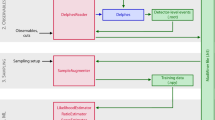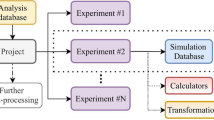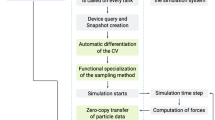Abstract
The programs ROYPROF, VEPFIT, and POSTRAP4 are widely used in the field of positron physics. They are mainly employed in analyzing experimental Doppler-broadened data from studying condensed matter samples with variable energy positron beams. A comparative study of analysis results on the same set of data has shown to be consistent. Performance differences are reported. The small differences found may not lead to wrong interpretation of physical results.
Similar content being viewed by others
Avoid common mistakes on your manuscript.
Introduction
Positron beam spectroscopy is used for studying condensed matter, in which controllable energy positrons are implanted into solid materials; herein they thermalize, diffuse, and then annihilate with core and valence electrons of the material resulting in emission of two photons of energies ≈511 keV. The diversion from the value 511 keV is a result of Doppler broadening of annihilation radiation caused by the momentum of electrons. The broadening is characterized by the shape parameters S and W. The profile of these parameters in terms of depth is influenced by the stopping profile P(z, E) and positron diffusion. Diffusion equation must be solved analytically in order to calculate the fraction of positrons that annihilate in each assumed state in the sample under study. Then the annihilation parameters are fitted as a function of energy in a nonlinear procedure[1].
Three programs are used by researchers in the field of positron physics for depth profiling of solid materials. These are ROYPROF written by the author[2], VEPFIT written by H Schut[3, 4], and POSTRAP4 written by GC Ares[5]. As these programs are based on calculating the fraction of positrons annihilating in each defined state, this process contains many fitting parameters that lead to a high possibility of obtaining good fits to experimental data. However, these fits may or may not represent the actual physical status. The only judge is the fitted parameters that must fall within an accepted range. In this study, the three programs are employed to fit the same set of data in order to find out how results compare.
Application of positrons to solids
In variable energy positron beams, positrons usually resulting from radioactive sources such as (22Na) are moderated and then transported under magnetic guidance to the sample chamber where they can be accelerated to desirable energies in the range 0 to 60 keV. The acceleration is done by applying different high voltages in order to probe different depths beneath the surface of the target sample.
For such incident energies, the positron stopping profiles are approximated by Makhovian distribution given by[6]:
where z denotes the depth into the solid from the surface,, Г is the gamma function, and m is known as shape parameter. The mean depth of positrons (Å) is related to the positron incident energy by
Here E is the positron energy (keV), ρ is the material’s density, and parameters A and n are material-related constants[7].
After the positrons have been implanted, they are likely to diffuse at thermal energies and can still propagate some distance randomly through the sample before they are annihilated freely in the lattice or at the surface, or possibly to be trapped prior to annihilation. The final distribution of thermal positrons is then given by solutions of one-dimensional stationary positron diffusion equation:
where the drift velocity V d = μ+ϵ(z) with μ+ as the positron mobility and ϵ(z) as the electric field strength. λ b is the annihilation rate and k(z) is the trapping rate. D+ is the diffusion coefficient and is related to the thermal diffusion length by where λeff is the effective annihilation rate.
The concentration of defects can be obtained by the use of the following relation:
where v is known as specific trapping rate[8, 9].
The programs are written to determine the fractions of positrons annihilating in each state of the sample by solving numerically the diffusion equation (3). These fractions are then fitted to the characteristics of shape parameters S or W for each state, such as
where Sepi, S s , S b , and S d correspond to 100% annihilation in epithermal, surface, bulk, and defect states, and F(E)’s are their respective fractions.
Experimental details
A Czochralski silicon (111) wafer was implanted with 50-keV nitrogen ions at room temperature with a dose of 3.5 × 1016 ions/cm2, and then the sample was studied with low-energy positron beam (TACITUS) at Royal Holloway, University of London. The gamma spectrum was collected for 0.5-h time duration for 53 energies in the range 0 to 25 keV, and then S parameter was calculated for each spectrum by dividing the sum of counts in 11 central channels of the 511-keV photopeak by the sum of counts in 101 channels representing the whole peak. Fifty three values of S parameter are then fitted to the diffusion model by each program. The results of this sample with results of other samples were used previously in studying defect range and nitrogen distribution in comparison with SIMS measurements and TRIM calculations[10].
Analysis
In order to have a systematic fitting procedure, the parameters A, n, and m are fixed to the values 3.67 μgm cm−2 keV−n, 1.55, and 2.0, respectively, as reported by Ghosh et al. for silicon[7]. These are fixed for all the fittings by the three programs. Other constants for silicon are taken as ρ = 2.33 g/cm3. Lattice constant for silicon = 0.543 nm, and annihilation rate for silicon 4.5 × 109 s−1. Diffusion coefficient D+ = 2.7 cm2/s, positron mobility in silicon = 60, and specific annihilation rate = 3 × 1014 s−1. Diffusion length in free silicon = 250 nm. In all fits, no electric field effects were considered.
ROYPROF fitting
The near-surface defect region model is used to fit the data. This model fits a rectangular profile of defects. The obtained results for the values of S parameters are 0.4854 (±0.0022), 0.5199 (±0.0013), 0.5088 (±0.0012), and 0.5393 (±0.0031) as the characteristics of epithermal, surface, bulk, and defect states. The scattering length of epithermal is 7.4 nm (±3.7). The defects are calculated to extend to a depth of 225 nm (±27) from the sample surface; these defects have a trapping rate of k = 18.6. Figure 1 represents this fit.
VEPFIT fitting
Model 4 of VEPFIT is used to fit the data; this model also fits a rectangular distribution of defects. The fitting zone is divided into 30 intervals starting with 0.8 nm with an increment factor of 1.38 nm. Best fitting with this model resulted in values for S parameters at 0.5092 (±0.0023), 0.5420 (±0.0028), 0.5172 (±0.0012), and 0.4863 (±0.0006) for bulk, defect, surface, and epithermal states, respectively. The depth of defect region extended to 263 nm (±12) with an effective diffusion length of 56.7 nm (±0.3). The epithermal scattering length is given at 7.3 nm (±1.4). The solid line in Figure 2 represents this fitting.
POSTRAP4 fitting
This program is mainly used for uniform defect distribution. One defect region was taken with 20 intervals for positron implantation, and free annihilation is calculated for 15,000 nm in depth. The implantation profile cutoff was taken as 1 × 10−6. The best fit resulted in values of S parameters at 0.5086 (±0.0042), 0.5428 (±0.0032), and 0.5091 (±0.0016) for surface, defect, and bulk states, respectively. The obtained defect depth was 260 nm (±10) with a defect concentration of 3 × 10−4. The solid line in Figure 3 represents this fit; it is noted that the line does not pass through the three lower energy points because POSTRAP4 does not incorporate the effects of epithermal positrons.
Discussion and comparison
The three programs have fitted the data well, and the obtained S values are summarized in Table 1.
The largest difference in the three calculated bulk S parameters is 0.004, and for defect S parameter, it is 0.0035. These differences are within the error fluctuation range; therefore, the differences for the bulk and defect values seem to be reasonable. Also, the two parameters are correlated and the calculation of trapping is done in each program in a different way. Values of S parameters for the surface state obtained by ROYPROF and VEPFIT are close; where the value obtained by POSTRAP4 is lower is clearly due to not incorporating epithermal effects in the program. It is important to compare these shape parameters because they influence other quantitative results such as diffusion lengths, defect concentrations, and depths. The ratio S d /S b is generally used to indicate the type of vacancy trapping; the ratio obtained from the fits is about 1.06 which is a characteristic of open volume defects in silicon. Comparable ratios have been reported for silicon defects; these values in the range of 1.04 to 1.10 are attributed to annihilations in divacancies to internal surfaces of large cavities[11]. Several authors have suggested a value for divacancies of 1.04[12, 13]. The value obtained here at 1.06 coincides with the study of nitrogen implanted silicon by Taylor et al.[14]. Other fitting results are summarized in Table 2.
The depth values of the defect region seem to be close between VEPFIT and POSTRAP4, and the value obtained from ROYPROF is about 13% lower, the likely cause of this difference is the proper boundaries chosen for each program since the actual distribution of defects is not uniform. The lower value is more consistent with the simulated depth of defects calculated using TRIM program[10]. There is a remarkable agreement between the programs for values of defect concentrations and effective diffusion lengths. The poor values of reduced chi square may have resulted from the experimental fluctuation of S values. These programs are employed to solve the diffusion equation (6) and obtain normalized fractions of positrons annihilating in each state for each energy. Surface state in all programs is considered absorbing. In ROYPROF and VEPFIT, a very small fraction at very low energy is eliminated and considered as a result of epithermal; this fraction is not eliminated in the case of POSTRAP and added to the surface state.
Figure 4a is a plot of positron fractions annihilating in the defect region and bulk of the material. These are plotted for ROYPROF and POSTRAP4. The curves obtained by ROYPROF are clearly shifted forward towards high energy and have higher values. This indicates that POSTRAP4 calculates a larger fraction annihilating at the surface, as a result of not taking the epithermal positrons into consideration. This can clearly be seen in Figure 4b where the curve obtained by POSTRAP4 for the fractions annihilating in the surface which is shifted forward as compared with the curve obtained from ROYPROF.
Conclusions
In conclusion, the present study has shown that positron annihilation Doppler parameter fittings with the three known programs ROYPROF, VEPFIT, and POSTRAP4 is consistent. The small differences observed may not lead to wrong interpretation of sample results. In addition, careful attention should be drawn towards choosing initial parameters and right constants when using these programs.
References
Krause-Rehberg R, Leipner HS: Positron Annihilation in Semiconductors: Defect Studies. Heidelberg: Springer; 1999.
Saleh AS, Taylor JW, Rice-Evans PC: The ROYPROF program for analyzing positron profiling data obtained from variable energy beams. Appl. Surf. Sci. 1999, 149: 87–96. 10.1016/S0169-4332(99)00179-8
van Veen A, Schut H, de Vries J, Haakvoort RA, Ijpma MR: Analysis of positron profiling data by means of VEPFIT. In Positron Beams for Solids and Surfaces, vol. 218. Edited by: Schultz PJ, Massoumi GR, Simpson PJ. New York: AIP; 1991:171–218.
Van Veen A, Schut H, Clement M, De-Nies JMM, Kruseman A, Ijpma MR: VEPFIT applied to depth profiling problems. Appl. Surf. Sci. 1995, 85: 216.
Aers GC: Defect profiling in multilayered systems using mean depth scaling. In Positron Beams for Solids and Surfaces, vol. 218. Edited by: Schultz PJ, Massoumi GR, Simpson PJ. New York: AIP; 1991:162–218.
Makhov AF: The penetration of electrons into solids. Sov. Phys. Solid State 1961, 2: 1934–1945.
Ghosh VJ: Positron implantation profiles in elemental and multilayer systems. Appl. Surf. Sci. 1995, 85: 187–195.
Schultz PJ, Lynn KG: Interaction of positron beams with surfaces, thin films and interfaces. Rev. Mod. Phys. 1988, 60: 3.
Coleman PG, Nash D, Edwardson CJ, Knights AP, Gwilliam RM: The evolution of vacancy-type defects in silicon-on-insulator structures studied by positron annihilation spectroscopy. J. Appl. Phys. 2011, 110: 016104. 10.1063/1.3605487
van der Werf DP, Saleh AS, Towner A, Nathwani M, Taylor J, Rice-Evans PC, Bull SJ: Defect profiling with low energy positrons of nitrogen implanted silicon. Mater. Sci. Forum 1999, 255–257: 500–502.
Schut H, van Veen A, van de Walle GFA, van Gorkum AA: Positron beam defect profiling of silicon epitaxial layers. J. Appl. Phys. 1991,70(6):3003. 10.1063/1.349329
Fujinami M, Chilton NB: A slow positron beam study of vacancy formation in fluorine‒implanted silicon. J. Appl. Phys. 1993, 73: 3242. 10.1063/1.352968
Goldberg RD, Schultz PJ, Simpson PJ: Determination of the characteristic signal for positron annihilation at divacancies in ion-irradiated silicon. Appl. Surf. Sci. 1995, 85: 287.
Taylor JW, Saleh AS, Rice-Evans PC, Knights AP, Jeynes C: Depth profiling of defects in nitrogen implanted silicon using a slow positron beam. Appl. Surf. Sci. 1999, 149: 175–180. 10.1016/S0169-4332(99)00196-8
Acknowledgements
None.
Author information
Authors and Affiliations
Corresponding author
Additional information
Competing interests
The author has no competing interests.
Authors’ original submitted files for images
Below are the links to the authors’ original submitted files for images.
Rights and permissions
Open Access This article is distributed under the terms of the Creative Commons Attribution 2.0 International License (https://creativecommons.org/licenses/by/2.0), which permits unrestricted use, distribution, and reproduction in any medium, provided the original work is properly cited.
About this article
Cite this article
Saleh, A.S. Analysis of positron profiling data by ROYPROF, VEPFIT, and POSTRAP4 codes: a comparative study. J Theor Appl Phys 7, 39 (2013). https://doi.org/10.1186/2251-7235-7-39
Received:
Accepted:
Published:
DOI: https://doi.org/10.1186/2251-7235-7-39








